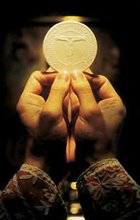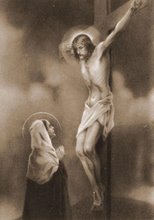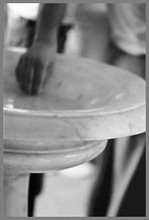Act of Resignation
Monday, June 30, 2008
Persecution & Martyrdom, Part IV
Act of Resignation
Friday, June 27, 2008
Persecution & Martyrdom, Part III
 Image: The first three Carthusian Martyrs who died by order of King Henry VIII. They were: Sts. John Houghton, Robert Lawrence and Augustine Webster, priors of the charterhouses of London, Beauvale and Axholme respectively.
Image: The first three Carthusian Martyrs who died by order of King Henry VIII. They were: Sts. John Houghton, Robert Lawrence and Augustine Webster, priors of the charterhouses of London, Beauvale and Axholme respectively."At the outset of the King's Great Matter (his divorce from Queen Catherine of Aragon so he could marry his mistress, Anne Boleyn), the government was anxious to secure the public acquiescence of the monks of the London Charterhouse, since for the austerity and sincerity of their mode of life they enjoyed great prestige. When this attempt failed in this, the only alternative was to annihilate the resistance, since a refusal engaged the prestige of the monks in the opposite sense." (source)
Act of Resignation
O Lord, my God, from this day I accept from your hand willingly and with submission, the kind of death that it may please you to send me, with all its sorrows, pains, and anguish. Into your hands, O Lord, I commend my spirit. Do with me what You will. Amen+
Thursday, June 26, 2008
Persecution & Martyrdom, Part II
Persecution & Martyrdom, Part I
 St. Thomas More comforting his daughter, Margaret on his way to the scaffold 6 July 1535 (aged 57), London, England. More's body was buried at the Tower of London, in the chapel of St Peter ad Vincula. His head was placed over London Bridge for a month after which it was rescued by his daughter, Margaret, before it could be thrown in the River Thames. His skull is believed to rest in the Roper Vault of St. Dunstan's, Canterbury.
St. Thomas More comforting his daughter, Margaret on his way to the scaffold 6 July 1535 (aged 57), London, England. More's body was buried at the Tower of London, in the chapel of St Peter ad Vincula. His head was placed over London Bridge for a month after which it was rescued by his daughter, Margaret, before it could be thrown in the River Thames. His skull is believed to rest in the Roper Vault of St. Dunstan's, Canterbury.Act of Resignation
O Lord, my God, from this day I accept from your hand willingly and with submission, the kind of death that it may please you to send me, with all its sorrows, pains, and anguish. Into your hands, O Lord, I commend my spirit. Do with me what You will. Amen+
Act of Humility

Our Share in Persecution

Friday, June 20, 2008
Our Lady of Siluva VI

In 1904, impatient with bearing these austere restrictions any longer, the Lithuanians rose in revolt against their Russian oppressors. Russia lost no time in quelling the revolution, but a number of restrictions were removed and Lithuania was given more freedom.
Pilgrimages to Siluva were resumed an organized basis in 1905. Many of the pilgrims took part in processions on foot to Siluva. It is a known fact that in the first year after the revolution of 1904, over 30,000 people visited the shrine of Our Lady of Siluva in organized pilgrimages.
In more recent times, perhaps one of the chief reasons that the Apparition was not recognized by the rest of the world, was the suppression of Religion and especially devotion to Our Lady in Siluva by the Soviet Union, during the occupation of Lithuania. Specifically, the Soviets dramatically discouraged visits to the shrine or even mention of it in the press. When special devotions were held at the site, cars were not allowed within four miles of the shrine, and the border was patrolled by the militia. Cars parked on the perimeter of this disallowed area were towed away or heavily fined. But one way or another, the faithful still managed to attend, risking much.
The government made it difficult for pilgrims to participate in the devotions: policemen used to stop and fine drivers without any real reason and block even the smallest roads. A soviet monument replaced the statue of Mary in the Town Square. Processions at that time were strictly prohibited and their organizers and participators punished and fired from their jobs, nevertheless pilgrims still went to Siluva. Friends of the Eucharist (the members of an underground Catholic association) were especially active in organizing the processions even though KGB cars followed people on the road.
On September 8, 1991, Cardinal Vincentas Sladkevicius and the Chairman of the Parliament Vytautas Landsbergis entrusted Lithuania to the Immaculate Heart of the Blessed Virgin Mary. The act of entrustment is kept in Siluva.
Thursday, June 19, 2008
Great Article - "Passing Hell's Gates"
The idea is not that Satan will never be able to get past the gates of the Church and prevail against the Bride of Christ in her sanctuary. What ridiculous nonsense. The idea is that Christians may march out against the greatest strongholds of the evil one, and bring the legions of hell to their knees."
Tuesday, June 17, 2008
Our Lady of Siluva V
 The Painting is the Finest Copy of Hodegetria
The Painting is the Finest Copy of HodegetriaIt has been discovered that the painting of Mary and the Christ Child brought by Peter Gedgaudas from Italy to the church in Siluva in 1457 is the finest copy of Hodegetria, one of St. Luke’s pictures, which was in Constantinople until 1453.
The same painting can be found in Rome in the Basilica of Santa Maria Maggiore.
In 1770, Fr. J. Skirmantas had a Goldsmith make a dress of gold for Our Lady in the painting.
Ona Smigelskaite of Vilnius, during the process of restoration of Our Lady's painting in 1959, discovered the signs of the picture having been folded – it had been folded four times and had been stored for a long time. This further confirms the picture's storage in the ironclad box.

Sunday, June 15, 2008
St. Edward the Confessor
Patron saint of kings
Place of burial: Westminster Abbey, London England
Our Lady of Siluva IV

In many apparitions of the Blessed Mother there is usually a picture or statue associated with the event. Our Lady of Siluva is not an exception. A blind man, more than 100 years old, lived in a nearby village. The stories of the apparitions reached him and he recalled a night, some eighty years before, when he helped Father Holubka bury an ironclad chest filled with church treasures beside a large rock. The villagers led him to the field of the apparitions to see if he could help locate the place where the treasures were buried. No sooner had he reached the spot, then his sight was miraculously restored. Falling to his knees with joy and gratitude, he pointed to the exact spot where the chest had been buried.
Villagers find the buried treasure
The ironclad chest was dug out of the ground and when it was opened, there – perfectly preserved – was the large painting of the Madonna and Child, several gold chalices, vestments, church deeds, and other documents. The painting was enshrined permanently in the Basilica of the Birth of the Blessed Virgin Mary and is venerated to this day as the Miraculous Image of Siluva.
Miracles continue
Over the years, many miracles have been recorded and the shrine has experienced numerous changes and larger churches had to be built to accommodate the pilgrims. Devotion to Our Lady of Siluva was growing until World War II brought about the destruction of freedom in Lithuania.
Since then, this world has seen many changes. We find ourselves surrounded by moral decay and many have lost their way. Today, Our Lady of Siluva is our most powerful intercessor before Almighty God.
She once brought Lithuania back to the Church, so let us pray that . . .
“ moved by your tears, may we as our forefathers did, revive the spirit of adoration of your Son in our hearts, strengthen the tottering structure of the shrine that is the family, bring back your wandering children and forgive the sins of our nation.
“ Our Lady of Siluva, intercede for your wandering children . . . bring them home to Jesus.”
Friday, June 13, 2008
Our Lady of Siluva III
The Blessed Virgin reappears
The Calvinist pastor, aware of the crowd that had gathered, became alarmed at the gullibility of his people in believing this “Roman superstition,” as he labeled the story. He warned them that this was the work of Satan, who wanted to lead them away. As the Calvinist pastor paused to catch his breath, a heart-rending sound of sobbing was heard. All eyes turned to the rock, and there, standing in their midst, was the weeping lady with the baby in her arms, just as the children had described her.
The people stood in amazement. The pastor, too, could do nothing but stare. The woman’s face was clouded in deep sorrow and her cheeks were bathed in bitter tears. Finally the pastor regained his composure and asked, “Why are you weeping?” In a voice filled with sorrowful emotion, she replied, “There was a time when my beloved Son was worshipped by my people on this very spot. But now they have given this sacred soil over to the plowman and the tiller and to the animals for grazing.” Without another word, she vanished.
People return to the Church
The belief that the Mother of God had appeared in person to chide them for their neglect of the Catholic Faith quickly grew among the people. Most of them heeded her message and began to return to the One True Church founded by her Divine Son, Jesus Christ. So complete was this return that a decade later, on the feast of the Nativity of the Blessed Virgin Mary, more than 11,000 people received Holy Communion during a mass offered at the scene of the apparitions.
A miracle occurs
Such was the miracle that the Mother of God wrought in the village of Siluva where there had been no church, no priest, no Mass, for almost eighty years. The Bishop appointed Fr. John Kazakevicius to investigate the phenomenon and question all witnesses to the events.
(source)
Thursday, June 12, 2008
Our Lady of Siluva II
Children see a beautiful woman on a rock
One summer day, in 1608, a number of children were tending their sheep in a field on the outskirts of the village of Siluva. They were playing near a large rock, close to a wooded section of the field, shouting merrily to one another in carefree fun. Suddenly one after another stood transfixed, staring in the direction of the rock. In the silence, there could be heard the sound of loud sobbing. Then the children beheld a beautiful young woman standing on the rock holding a baby in her arms and weeping bitterly. Her overwhelming grief was only too evident. She did not speak, but looked at them sadly as she stood there, weeping as though her heart was breaking. So profuse were her tears that they ran down her cheeks and some of them splashed on the rock. The woman was dressed in flowing blue and white robes, unlike any costume with which the children were familiar. Her long, light-brown hair fell softly over her shoulders. A strange light surrounded both the woman and child.
Boy runs to Calvinist pastor
So startled were the children, they could not speak, but merely stood and stared. Amazement soon turned to fright when the woman with her baby disappeared as mysteriously as she had appeared. Then all began to talk excitedly about what they had seen. One of the boys ran to the village to tell the Calvinist pastor. He was told to stop making up such a fantastic tale and to go back to the fields.
Children tell their parents
When the children returned home in the evening, they told their parents and neighbors about the weeping woman. The news spread quickly through the little village, and the next morning most of the townspeople had gathered around the rock. Some were scoffing loudly, but others were impressed by the children's tearful insistence that they were telling the truth. This was proven because, whether the children were questioned separately or together, each told the same identical story, even to the smallest detail.
Tuesday, June 10, 2008
Our Lady of Siluva I
Lithuania becomes the youngest daughter of the Church. In 1251, Lithuania was the last European nation to accept Christianity, becoming the youngest daughter of the Church.
There was a time when Lithuania came very close to leaving the Catholic faith. Something happened in 1608 in the little village of Siluva which turned back, once and for all, the tide of the Reformation heresy which was sweeping over Europe and threatening to engulf this little country.
Two hundred fifty years before Lourdes and Fatima the Blessed Virgin Mary appeared in the village of Siluva, Lithuania. The story begins in 1457.
The story of Our Lady of Siluva actually began in 1457, when Peter Giedgaudas, a diplomat for Vytautas the Great, built the first church in the area and gave the land to the Catholic Church. On one of his many travels he went to Rome and there obtained a magnificent painting of the Blessed Virgin Mary holding the child Jesus. He brought the painting back to Lithuania and put it in the sanctuary of the new church in Siluva.
For several generations the faithful worshiped God and honored the Blessed Mother in their little shrine church.
Calvinist Controversy
When the Protestant "Reformation" swept over Europe, not even this little village escaped its impact. In 1532, the local governor became a zealous Calvinist as did many nobility and intellectuals . . . they in turn forced their will upon the people. The Catholics of Siluva were helpless to resist the repression of their Faith by the powerful gentry. Property owned by the Church was to be confiscated and the land turned over to the Calvinists.
Parish priest hides the treasured painting
When Fr. John Holubka, the parish priest of the Siluva Church, heard what was to happen, he built an ironclad box. He carefully wrapped the treasured painting of the Blessed Virgin Mary and Child, liturgical vestments, and documents which proved that Vytautas the Great had given the land to the Catholic Church and placed them in the box. Then he sealed the box and buried it deep in the ground near a large rock. His action was truly inspired because a short time later the authorities seized the church. It seemed as if the Catholic faith had come to an end in the once fervent village of Siluva.
To those in moral sin...

THIS IS YOUR HOUR OF MERCY!
To those enslaved by pornography,
Come to Me, the Image of God
To those who are committing adultery,
Come to Me, the Faithful One
To prostitutes, and those who use or sell them,
Come to Me, your Beloved
To those engaging in unions outside the bounds of marriage,
Come to Me, your Bridegroom
To those who worship the god of money,
Come to Me, without paying and without cost
To those in witchcraft or bound in the occult,
Come to Me, the Living God
To those who have made covenant with Satan,
Come to Me, the New Covenant
To those drowning in the abyss of alcohol and drugs,
Come to Me, who am Living Waters
To those enslaved in hatred and unforgiveness,
Come to Me, Fount of Mercy
To those who have taken the life of another,
Come to Me, the Crucified One
To those who are jealous and envious, and murder with words,
Come to Me, who am jealous for you
To those who are enslaved by love of self,
Come to Me, who has laid down His life
To those who once loved me, but have fallen away,
Come to Me, who refuses no soul…. and I will blot out your offences, and forgive your transgressions. I will remove your sins, as far as the east is from the west. In the name of the Father, the Son, and the Holy Spirit, I command the chains which hold you to be broken. I command every principality and power to release you. I open my Sacred Heart to you as a hiding place and refuge. I will refuse no soul who returns to Me trusting in My infinite Mercy and Love.
THIS IS YOUR HOUR OF MERCY

Monday, June 9, 2008
Black Scapular

Remember the promises for devotion to Our Lady's Sorrows?
The following are the seven graces promised by the Blessed Virgin Mary to souls who honor her daily by saying seven Hail Mary's and meditating on her tears and sorrows. This devotion was passed on to us by Saint Bridget, who received them directly from Our Lady.
1. "I will grant peace to their families."
2. "They will be enlightened about the divine mysteries."
3. "I will console them in their pains and I will accompany them in their work."
4. "I will give them as much as they ask for as long as it does not oppose the Adorable Will of my Divine Son or the sanctification of their souls."
5. "I will defend them in their spiritual battles with the infernal enemy and I will protect them at every instant of their lives."
6. "I will visibly help them at the moment of their death; they will see the face of their mother."
7. "I have obtained (this Grace) from my Divine Son, that those who propagate this devotion to my tears and sorrows, will be taken directly from this earthly life to eternal happiness since all their sins will be forgiven and my Son will be their eternal consolation and joy."
Black Scapular is a Catholic sacramental of the Order of Friar Servants of Mary (Servites)A.D. 1240 "The Black Scapular of the Seven Dolors of Mary," or "The Our Lady of Sorrows Scapular," has on its front a depiction of Our Lady of Sorrows. Our Lady appeared to seven rich and prominent citizens of Florence who decided to give up their worldly possessions and follow Christ, promising to honor His Mother in her sorrows. Thus began the Servite Order. Mary gave them the Servite habit and said that "these garments shall be to you a perpetual memory of the sufferings of my heart." This is available to everyone now through the more common Black Scapular. The General of the Servite Order has granted the faculty of investment with this scapular to other priests.
Buy one, wear it, compassionate our Lady's Sorrows and your reward will be great in Heaven!
Friday, June 6, 2008
Joy in Suffering

Tuesday, June 3, 2008
New English Marian Shrine

Monday, June 2, 2008
St. Winifred III

The holy spring of St Winifred, an important center of medieval pilgrimage still venerated today, is said to have risen where St Beuno restored his niece St Winifred to life after her head had been severed by Cardoc, a rejected local chieftan suitor. St Beuno is a well-attested 7th-century figure, responsible for bringing Celtic monasticism to much of north Wales.
The spring became renowned for its healing powers and throughout the centuries and even until today, pilgrims travel here in their thousands from all over the world to bathe in its waters and worship at its shrine that has become known as the Lourdes of Wales. The holy well is mentioned in an old rhyme as one of the Seven Wonders of Wales
 (photo credit)
(photo credit)The Jesuits have traditionally supported the holy well.
It is also believed to be connected to St Mary's well and chapel in Cefn Meiriadog, Denbighshire.
As one of the few locations mentioned by name in the anonymous medieval alliterative poem Sir Gawain and the Green Knight, it is interesting to compare the site's beheading history with the beheading game in the poem.






















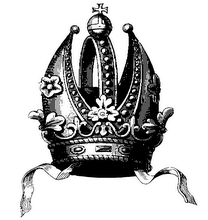
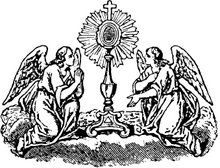








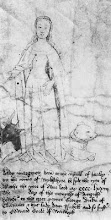01.jpg)














